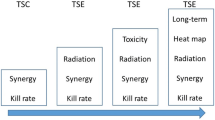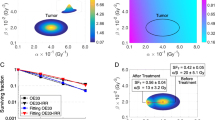Abstract
To treat animal dose–response data exhibiting inverse dose–response behavior with two tumor control probability (TCP) models accounting for tumor hypoxia and re-oxygenation leading to resensitization of the tumor. One of the tested TCP models uses a modified linear-quadratic (LQ) model of cell survival where both α and β radiosensitivities increase in time during the treatment due to re-oxygenation of the hypoxic tumor sub-population. The other TCP model deals with two types of hypoxia—chronic and acute—and accounts for tumor re-sensitization via oxygenation of the chronically hypoxic and fluctuating oxygenation of the acutely hypoxic sub-populations. The two models are fit using the maximum likelihood method to the data of Fowler et al. on mice mammary tumors irradiated to different doses using different fractionated schedules. These data are chosen since as many as five of the dose–response curves show an inverse dose behavior, which is interpreted as due to re-sensitization. The p-values of the fits of both models to the data render them statistically acceptable. A performed comparison test shows that both models describe the data equally well. It is also demonstrated that the most sensitive (oxic) tumor component has no impact on the treatment outcome. The ability of the tested models to predict and describe the impact of re-sensitization on the treatment outcome is thus proven. It is also demonstrated that prolonged treatment schedules can be more beneficial than shorter ones. However, this may be true only for schedules with small number of fractions, i.e. for hypo-fractionated treatments only.



Similar content being viewed by others

References
Munro TR, Gilbert CW (1961) The relation between tumour lethal doses and the radiosensitivity of tumour cells. Br J Radiol 34:246–251
Hanin LG (2004) A stochastic model of tumor response to fractionated radiation: limit theorems and rate of convergence. Math Biosci 191(1):1–17
Hanin LG, Zaider M, Yakovlev AY (2001) Distribution of the number of clonogens surviving fractionated radiotherapy: a long-standing problem revisited. Int J Radiat Biol 77(2):205–213
Kendal WS (1998) A closed-form description of tumour control with fractionated radiotherapy and repopulation. Int J Radiat Biol 73(2):207–210
Tucker SL, Thames HD, Taylor JM (1990) How well is the probability of tumor cure after fractionated irradiation described by Poisson statistics? Radiat Res 124(3):273–282
Yakovlev AY (1993) Comments on the distribution of clonogens in irradiated tumors. Radiat Res 134(1):117–120
Zaider M, Minerbo GN (2000) Tumour control probability: a formulation applicable to any temporal protocol of dose delivery. Phys Med Biol 45(2):279–293
Kendall DG (1948) On the generalized “birth-and-death” process. Ann Math Stat 19(1):1–15
Stavreva NA et al (2003) Investigating the effect of cell repopulation on the tumor response to fractionated external radiotherapy. Med Phys 30(5):735–742
Fischer JJ, Moulder JE (1975) The steepness of the dose-response curve in radiation therapy. Theoretical considerations and experimental results. Radiology 117(1):179–184
Stavreva NA et al (2005) Investigating the effect of clonogen resensitization on the tumor response to fractionated external radiotherapy. Med Phys 32(3):720–725
Fowler JF et al (1974) Optimum fractionation in X-ray treatment of C3H mouse mammary tumours. Br J Radiol 47(563):781–789
Fischer JJ (1971) Mathematical simulation of radiation therapy of solid tumors. I. Calculations. Acta Radiol Ther Phys Biol 10(1):73–85
Nakamura K, Brahme A (1999) Evaluation of fractionation regimens in stereotactic radiotherapy using a mathematical model of repopulation and reoxygenation. Radiat Med 17(3):219–225
Ruggieri R (2004) Hypofractionation in non-small cell lung cancer (NSCLC): suggestions from modelling both acute and chronic hypoxia. Phys Med Biol 49(20):4811–4823
Ruggieri R, Nahum AE (2006) The impact of hypofractionation on simultaneous dose-boosting to hypoxic tumor subvolumes. Med Phys 33(11):4044–4055
Ruggieri R et al (2012) Applying a hypoxia-incorporating TCP model to experimental data on rat sarcoma. Int J Radiat Oncol Biol Phys 83(5):1603–1608
Stavrev P et al (2021) The impact of different timing schedules on prostate HDR-mono-brachytherapy. A TCP modeling investigation. Cancers 13(19):4899
Stavrev PV et al (2021) Theoretical investigation of the impact of different timing schemes in hypofractionated radiotherapy. Med Phys 48(7):4085–4098
Stavreva N, Stavrev P, Fallone GB (2009) Confidence limits of the probability of success in animal experiments and clinical studies: a Bayesian approach. Phys Med 25(1):43–46
Shaeffer J, El-Mahdi AM, Merz T (1972) In vivo and in vitro radiation responses of a sensitive spontaneous mouse mammary adenocarcinoma. Cancer 29(3):581–584
Porter EH (1980) The statistics of dose/cure relationships for irradiated tumours. Part II. Br J Radiol 53(628):336–345
Porter EH (1980) The statistics of dose/cure relationships for irradiated tumours. Part I. Br J Radiol 53(627):210–227
Stavrev P et al (2015) On differences in radiosensitivity estimation: TCP experiments versus survival curves. A theoretical study. Phys Med Biol 60(15):N293–N299
Alite F et al (2016) Local control dependence on consecutive vs. nonconsecutive fractionation in lung stereotactic body radiation therapy. Radiother Oncol 121(1):9–14
Acknowledgements
This work was supported by the Bulgarian National Science Fund under Contract: DN 18/4 (10.12.2017).
Funding
Funding was provided by Bulgarian National Science Fund (DN 18/4 (10.12.2017).
Author information
Authors and Affiliations
Corresponding author
Ethics declarations
Conflict of interest
The authors declare no conflict of interest.
Additional information
Publisher's Note
Springer Nature remains neutral with regard to jurisdictional claims in published maps and institutional affiliations.
Appendices
Appendix 1
The Zaider–Minerbo TCP model solved for the case of (n) external fractions is:
where N is the initial number of tumor cells, λ and μ are the cell birth rate and the cell natural death rate correspondingly, \(T_{n - 1}\) is the total treatment time, \(T_{k - 1}\) is the time until after the kth fraction, \(p_{s} \left( {T_{k - 1} } \right)\) is the cell survival probability after the kth fraction. If the linear-quadratic (LQ) model with complete repair of the sub-lethal cell damage between fractions is assumed, \(p_{s} \left( {T_{k - 1} } \right)\) is:
where \(d_{i}\) is the dose per the ith fraction delivered homogeneously and α and β are the radiosensitivity parameters of the LQ model. The LQ model parameters are considered to be constants in time in the widely accepted version of the LQ model. However, a version of the model was developed in [11] where the cell radiosensitivity, α, increases in time according to the following function:
Parameter b in Eq. (5) determines the rate of re-oxygenation and hence the rate of re-sensitization of the initially hypoxic region of the tumor. \(\alpha_{0}\) is the initial low value of \(\alpha\) in the hypoxic region of the tumor and \(\alpha_{m}\) is the maximum possible value of α reached asymptotically in time. The cell survival probability is then calculated according to:
In this study we assume that radio-sensitivity, β, also increases with time simultaneously with α according to the following function:
where \(\beta_{0} {\text{ and }}\alpha_{{0}}\) are the initially low values of β and α. The above relationship applied to the maximum (oxygenated) values of \(\beta_{ \, } {\text{and }}\alpha\), \(\beta_{m} {\text{ and }}\alpha_{m}\), results in the following accepted relation between the oxygen enhancement ratios (OERs) of the radio-sensitivity parameters: \(\frac{{\beta_{m} }}{{\beta_{0} }} = OER_{\beta } = \left( {\frac{{\alpha_{m} }}{{\alpha_{0} }}} \right)^{2} = \left( {OER_{\alpha } } \right)^{2}\).
This version of the model retains the number of free parameters as in the version of the model where β is constant.
For the case of both α and β changing in time Eq. (4) transforms into:
where \(\alpha \left( {t_{i} } \right)\) and \(\beta \left( {t_{i} } \right)\) are calculated according to Eqs. (5) and (7) for the moment of the ith fraction delivering dose \(d_{i}\) correspondingly.
Appendix 2
The TCP is calculated according to a Poisson based expression:
where \(N_{s}\) is the sum of the mean number of surviving oxic,\(N_{o}^{n}\), acutely hypoxic, \(N_{ah}^{n}\), chronically hypoxic, \(N_{ch}^{n}\), and chronically hypoxic turned oxic cells, \(\tilde{N}_{o}^{n}\), after n fractions of irradiation. The mean number of oxic cells surviving n fractions of irradiation to dose d per fraction is:
where \(N_{o}^{o}\) is the initial number of oxic cells and T is the total treatment time, λ is the cell repopulation rate, \(S_{o} = e^{{ - \alpha_{o} d - \beta_{o} d^{2} }}\) is the cell survival probability according to the LQ model of the oxic cells after irradiation to dose d.
The mean number of acutely hypoxic cells after n fractions of irradiation to dose d per fraction is:
where \(N_{ah}^{o}\) is the initial number of acutely hypoxic cells and \(S_{ah} = e^{{ - \alpha_{ah} d - \beta_{ah} d^{2} }}\) is the cell survival probability of the acutely hypoxic cells when irradiated to dose d.
The mean number of chronically hypoxic cells surviving n fractions of irradiation to dose d per fraction is:
where \(N_{ch}^{o}\) is the initial number of chronically hypoxic cells, \(1 - B(\Delta t_{i} ) = e^{{ - a\Delta t_{i} }}\) is the fraction of chronically hypoxic cells, which remain hypoxic between the \(i{\text{th}}\) and the \((i + 1){\text{th}}\) irradiation and \(S_{ch} = e^{{ - \alpha_{ch} d - \beta_{ch} d^{2} }}\) is the cell survival probability of the chronically hypoxic cells when irradiated to dose d.
The mean number of chronically hypoxic turned oxic cells surviving n fractions of irradiation to dose d per fraction is:
and \(B(\Delta t_{i} ) = 1 - e^{{ - a\Delta t_{i} }}\) is the fraction of chronically hypoxic cells, which re-oxygenate between the \(i{\text{th}}\) and the \((i + 1){\text{th}}\) irradiation.
Rights and permissions
Springer Nature or its licensor holds exclusive rights to this article under a publishing agreement with the author(s) or other rightsholder(s); author self-archiving of the accepted manuscript version of this article is solely governed by the terms of such publishing agreement and applicable law.
About this article
Cite this article
Stavrev, P., Stavreva, N., Ruggieri, R. et al. Analysis of tumour dose–response data from animal experiments via two TCP models accounting for tumor hypoxia and resensitization. Phys Eng Sci Med 45, 1093–1102 (2022). https://doi.org/10.1007/s13246-022-01173-9
Received:
Accepted:
Published:
Issue Date:
DOI: https://doi.org/10.1007/s13246-022-01173-9



